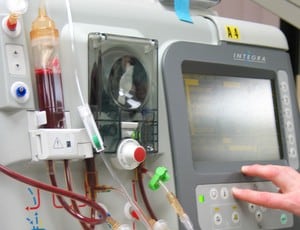How to decrease central line-associated bloodstream infections

To study the impact of a quality improvement (QI) initiative using care bundle approach on Central-line associated bloodstream infections (CLABSI) rates” Balla et al (2018). Abstract: OBJECTIVE: To study the impact of a quality improvement (QI) initiative using care bundle approach on Central-line associated bloodstream infections (CLABSI) rates. METHODS: A QI team for infection control […]
Current status of dialysis and vascular access in Taiwan

However, the statistics and vascular access monitoring are relatively insufficient in the past. The comprehensive integration of vascular access management into public policy related to kidney disease will complete the missing piece of the puzzle of overall care” Chen et al (2018), Abstract: Due to the implementation of the National Health Insurance system in 1995, […]
Intravenous fluid treatment for migraine headache

This pilot study showed no statistically significant treatment effect from fluid administration, but does not exclude the possibility of a clinically important treatment effect” Jones et al (2018). Abstract: Study objective: The objective of this pilot study is to assess the feasibility and necessity of performing a large-scale trial to measure the effect of intravenous […]
Evaluation of a novel flushing protocol for a peripherally inserted central catheter

We investigated whether a novel flushing method for PICCs could decrease the risk of venous thromboembolism (VT) and catheter-associated bloodstream infections (CABSIs) compared to the traditional flushing method” Liu et al (2018). Abstract: BACKGROUND: Peripherally inserted central catheters (PICCs) are increasingly used in critical care units. Venous arterial blood management protection (VAMP) for PICCs could […]
Caution when using pumps for intravenous fluid infusion on a tucked limb

Cost-utility of OPAT compared to Inpatient Parenteral Antimicrobial Therapy (IPAT)

This study assesses the cost-utility of OPAT compared to Inpatient Parenteral Antimicrobial Therapy (IPAT) from the perspective of a public university hospital and the Brazilian National Health System (SUS)” Psaltikidis et al (2018). Abstract: BACKGROUND: Outpatient Parenteral Antimicrobial Therapy (OPAT) has been used for decades in different countries to reduce hospitalization rates, with favorable clinical […]
Continuous infusion ampicillin for the outpatient management of Enterococcal endocarditis

Studies evaluating ampicillin stability utilizing high-pressure liquid chromatography have indicated enhanced stability (greater than 24 hours at room temperature), supporting outpatient administration” Lewis et al (2018). Abstract: Treatment of enterococcal endocarditis requires up to 6 weeks of intravenous (IV) antimicrobial therapy. When susceptible, an ampicillin-based regimen is preferred. Studies evaluating ampicillin stability utilizing high-pressure liquid […]
Systematic review of fluid challenge during anesthesia

The key components of FC including type of fluid (colloids, often 6% HES), volume (500 and 250 mL in non-GDT studies and GDT studies, respectively), and time of infusion (10 minutes) are quite standardized in operating room” Messina et al (2018). Abstract: BACKGROUND: Assessing the volemic status of patients undergoing surgery is part of the […]
Clinical review of Sherlock-3CG® for positioning PICC

Our study could not demonstrate any specific advantage of Sherlock-3CG either as a magnetic-based tip navigation method or as an electrocardiogram-based tip location method” Pittiruti et al (2018). Abstract: INTRODUCTION: Intracavitary electrocardiogram technique is recognized as a safe, accurate, and inexpensive method for verifying the tip location of central venous access devices. While the technique […]
ASPEN guidelines for the selection and care of CVAD

This document represents the American Society for Parenteral and Enteral Nutrition (ASPEN) clinical guidelines to describe best practices in the selection and care of central venous access devices (CVADs) for the infusion of home parenteral nutrition (HPN) admixtures in adult patients” Kovacevich et al (2018). Abstract: This document represents the American Society for Parenteral and […]
Outcomes associated with the use of 2.6-Fr double-lumen PICCs in neonates

To determine feasibility of 2.6-French (Fr) double-lumen PICCs in newborns and compare noninfectious complications such as thrombus formation, catheter breakage, infiltration, and accidental dislodgment and central line-associated bloodstream infection (CLABSI) rate with that of newborn infants treated with 1.9-Fr single- and double-lumen PICCs” OʼMalley et al (2018). Abstract: BACKGROUND: Low birth-weight infants’ survival continues to […]
Changes to indications for tunneled cuffed catheter use in hemodialysis patients

As the number of elderly end-stage renal disease patients lacking suitable vessels for arteriovenous fistula (AVF) is increasing, indications for tunnel cuffed catheters (TCCs) may be expanding. This study aimed to clarify changes over time in the number of patients with TCC and indications for TCCs” Okamoto et al (2018). Abstract: INTRODUCTION: As the number […]
Non-specific symptoms in adult patients referred to a Lyme centre

There is controversy whether non-specific symptoms can be related to previous Lyme borreliosis (LB). Positive serology can be considered a proxy for a previous or persistent infection with LB. We assessed non-specific symptoms and serology in patients suspected of LB referred to a Lyme centre” Zomer et al (2018). Abstract: Objectives: There is controversy whether […]
Impact of interprofessional learning on vascular access training

This study explores and critically evaluates the impact of educational leadership on practitioner development and clinical practice, focusing specifically on paediatric vascular access” Hulse and Cochrane (2018). Abstract: Educational leadership supports the effective transfer of knowledge and clinical skills between practitioners. Evaluation of training is imperative to ensure safe and effective transfer of learning into […]
Review of the Vacuderm single-use tourniquet shows significant increase in venous diameter

This article reports on research investigating the effectiveness of an innovative device called the Vacuderm—a single-use tourniquet with added manual vacuum pump—in increasing vein dimensions, temperature difference between vein and its surrounding and visual clarity through an additional effect of creating a vacuum on top of the tourniquet” Asrar et al (2018). Abstract: Vascular access […]
Device to improve non-coring needle insertion into implanted intravenous ports

Implanted intravenous ports (IPs) are increasingly used in health care. The experience of having IPs accessed can vary a great deal for patients. Successful IP access depends on the experience and skill of the health professional and wrongly positioned attempts are not only painful for the patient but can also cause damage to the outer […]
Empirical vancomycin dosing strategy for obese and super obese adults

To determine an empirical vancomycin dosing strategy for obese and super obese adults that is consistent with the AUC monitoring paradigm” Crass et al (2018). Abstract: Background: Vancomycin remains the mainstay of empirical therapy directed against MRSA. National guidelines recommend empirical dosing based on total body weight with trough-level therapeutic drug monitoring (TDM), which may […]
Interventions to reduce unnecessary central venous catheter use

To identify, describe, and evaluate interventions to reduce unnecessary central venous catheter (CVC) use to prevent central-line-associated bloodstream infections (CLABSIs) in adults” Xiong and Chen (2018). Abstract: OBJECTIVE: To identify, describe, and evaluate interventions to reduce unnecessary central venous catheter (CVC) use to prevent central-line-associated bloodstream infections (CLABSIs) in adults. DESIGN: Systematic review. METHODS: The […]
Incidence and risk factors for needlestick injuries amongst Malaysian HCWs

To determine the national self-reported incidence and risk factors for NSI among Malaysian Ministry of Health (MOH) HCWs” Ishak et al (2018). Abstract: BACKGROUND: Needlestick injury (NSI) is a significant occupational health issue among healthcare workers (HCWs). AIMS: To determine the national self-reported incidence and risk factors for NSI among Malaysian Ministry of Health (MOH) […]
Patient satisfaction following insertion of tunnelled central venous catheter

We performed a randomised control trial comparing the effects of pain, sedation, amnesia and overall patient satisfaction between PCS and RCS, by enrolling forty patients undergoing insertion of a tunnelled central line” Clements et al (2018). Abstract: INTRODUCTION: Interventional Radiology procedures can provoke anxiety and may be painful. Current practice, Radiologist Controlled Sedation (RCS), involves […]
Review of doctors attitudes towards medication errors

The purpose of this paper is to explore the attitudes and beliefs of doctors towards medication error reporting following 15 years of a national patient safety agenda” Burns et al (2018). Abstract: Purpose: The purpose of this paper is to explore the attitudes and beliefs of doctors towards medication error reporting following 15 years of […]
Implementation of infection control bundles in intensive care units

Nosocomial infections (NIs) are devastating complications in intensive care units (ICUs) with high mortality and morbidity. NIs increase both the length of stay and hospital charges and may lead to the lifelong disability of patients” Alp and Rello (2018). Abstract: Nosocomial infections (NIs) are devastating complications in intensive care units (ICUs) with high mortality and […]
Epidemiology and microbiology of peripheral line–associated bloodstream infection (PLABSI)

We retrospectively studied the epidemiology and microbiology of peripheral line–associated bloodstream infection (PLABSI) in comparison with central line–associated bloodstream infection (CLABSI)” Tsuboi et al (2018). Abstract: We retrospectively studied the epidemiology and microbiology of peripheral line–associated bloodstream infection (PLABSI) in comparison with central line–associated bloodstream infection (CLABSI). Among 2,208 bacteremia episodes, 106 (4.8%) PLABSI and […]
Identifying the incidence of infiltration and extravasation in newborns

The objective of this study was to identify the incidence of infiltration and extravasation in newborns using peripheral venous catheter, and affecting factors” Atay et al (2018). Abstract: OBJECTIVE: The objective of this study was to identify the incidence of infiltration and extravasation in newborns using peripheral venous catheter, and affecting factors. METHOD: This observational […]
Incidence and management of infusion reactions to infliximab

The aim of this study was to evaluate the incidence of IRs following administration of infliximab and associated management approaches in an alternate care setting” Checkley et al (2018). Abstract: BACKGROUND: Infliximab is a chimeric anti-tumor necrosis factor alpha (TNF-α) monoclonal antibody that ameliorates inflammation when it binds to and neutralizes TNF-α. It is often […]
Focus on the management thrombosis in pediatric malignancy

This review aims to examine current knowledge regarding the incidence, risk factors, clinical manifestation, evaluation, prevention, and management of thromboembolic events in children with cancer” Bordbar et al (2018). Abstract: Venous thromboembolism (VTE) result in significant morbidity and mortality in children with cancer. The cause of VTE in children with cancer is multifactorial and includes […]
Intraosseous administration of hypertonic saline case study

Intraosseous administration of 23.4% saline in 6 adult patients with neurological emergencies was feasible and should be considered in cases where obtaining intravenous access is time consuming” Farrokh et al (2018). Abstract: BACKGROUND: Rapid administration of hypertonic saline 23.4% is crucial in treatment of herniation syndromes. Hypertonic 23.4% saline must be administered via a central […]
Validity and reliability of an infiltration scale in infants

The infiltration scale is a valid and reliable scale in infants. The validity and reliability of the scale has been verified and may be used in the identification of infiltration in infant gestational age between 24 and 39 weeks and weighing
Central venous catheter placement in a persistent left-sided superior vena cava

This case report describes placement of a dialysis catheter in a 55-year-old patient with PLSVC and subsequent complications following the uncertainty of the placement” Bak and Nørskov (2018). Abstract: Persistent left-sided superior vena cava (PLSVC) is a central venous anomaly in up to 0.5% of the population. It is usually asymptomatic due to drainage into […]
Tunneled central venous catheters in pediatric intestinal failure

Parenteral nutrition for intestinal failure (IF) often requires a tunneled central venous catheter (CVC). The purpose of this study was to characterize complications after CVC placement and contributors to line loss in pediatric IF patients” Anderson et al (2018). Abstract: BACKGROUND: Parenteral nutrition for intestinal failure (IF) often requires a tunneled central venous catheter (CVC). […]

